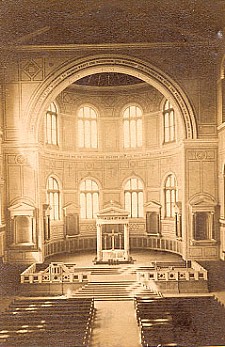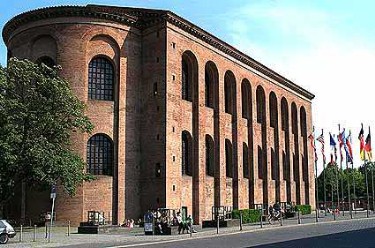1999.04.01 13:06
aesthetics of war design
What I realized while viewing through some of the [destruction] images is that I could take pictures walking around my own neighborhood of Olney in urban Philadelphia, USA, and they would be very similar to those of Kosovo today. Of course, what's going on in Kosovo now is extremely upsetting, but what's equally upsetting is that destruction is not just going on there but in many, many places on this planet.
Perhaps the aesthetic of war design is more prevalent than we most times realize.
1999.04.01 21:32
aesthetics of war design
...or, if you take an inverted view, maybe it's all just a (theoretical) war of (philosophical) ruins...
1999.04.01 21:37
aesthetics of war design
...discovering that the first master architect of Christianity was a woman.
| |
2005.04.01 10:55
Quest for architect baby - Frank Lloyd-Wrightenstein!
Not too ironic though when you consider all the Wright, Mies, Corbusier, etc. clone architecture all over the global environment.
Church inseminated synagogue procreates mosque?
2005.04.01 14:55
how should someone feel after visiting a museum?
If it's an exceptional avant-garde museum, then according to design appropriateness, and even according to 'sustainable design' standards, the visitor should feel sucked in, confused, inadequate and, of course, an aftershock of wanting more.
| |
2006.04.01 10:08
Complex Iconography and Contradictory Content in Architecture
It's strange to think that the double basilica of Augusta Treverorum [Trier] (circa 326-8 AD) was the first Christian basilica of northern Europe, and for many years the largest Christian church of northern Europe as well. Little remains of the original double basilica, but two large churches are still there side by side today.
My theory as to why there were two joined basilicas, to begin with, is that they were designed to accommodate the distinct Latin and Greek populations of Augusta Treverorum. I also theorize the double basilica of Augusta Treverorum as the primogenitor of the Romanesque. Eutropia was the 'architect'.
While the Shroud of Turin is well known, the Holy Coat of Trier is much lesser known. Perhaps you know the movie The Robe, however. "The Trier tradition affirms that this relic was sent to that city by the Empress St. Helena." If this tradition is true, Helena was already dead when the Holy Coat was brought to Augusta Treverorum. It was Eutropia who executed the translation of the relic.
The head of Helena, empress and saint, is also in one the double churches at Trier.
Did Eutropia ultimately die at Augusta Treverorum? Albeit a Syrian, as a western Roman Empress herself, she certainly was no stranger to the city. It is at least known that Constantine was at Augusta Treverorum 27 September 328 and 29 December 328 while on a campaign on the Rhine. Coincidentally, the end of 328 and the beginning of 329 is exactly when coins depicting Helena Augusta stopped being issued. It has long been my contention that the Helena coins ceased once Eutropia had died.
How come architecture historians have yet to make the very direct connection between Constantine's throne hall at Augusta Treverorum (306 AD) and the first Christian basilica of Rome (312 AD)? Perhaps it is only obvious to Eutropia, Helena and Constantine and those who know them as to where the "basilican" form of the Early Christian Architecture actually came from.
| |
2006.04.01 10:19
Why does much 'avant-garde' design these days look straight out of the Sixties?
And familiarity and associations are based on memories, either empirical or received via education, and memories are nothing if not reenactments. Add to that that architects are for the most part conservative, and radical only rarely.
2006.04.01 11:30
Why does much 'avant-garde' design these days look straight out of the Sixties?
I like the question, "What would radical be exactly?" because it's kind of indicative of how rare radicalism in architecture really is...
radical
2.Departing markedly from the usual or customary; extreme
3. Favoring or effecting fundamental or revolutionary changes in current practices, conditions, or institutions
2006.04.01 14:24
Why does much 'avant-garde' design these days look straight out of the Sixties?
...I was reminded of being in a local 1960s Roman Catholic church for the first time a few years ago. I was actually quite surprised by it's "radical-ness". I mean, it was the first time I've ever seen a completely black altar in my life. There was indeed something radical about a lot of 60s and 70s architecture.
2006.04.01 17:12
Why does much 'avant-garde' design these days look straight out of the Sixties?
A couple of years ago I specifically looked through the Progressive Architecture design awards from the late 1960s. I wanted to see what Gordon Matta-Clark probably saw himself when he was (still) in architecture school at Cornell. I was very much surprised because a lot of the top prizes were buildings that are now "in history", but not all of them. I'm not sure how this relates to the topic here, but what I saw wasn't exactly what I expected. I guess I'm trying to say that history gets more interesting when it's contextually specific. Is radical retro an option? Extreme Makeover Retro?
| |
13040101 New Not There City Las Vegas scan 2413i10
13040102 New Not There City Eutropia 206bi05
13040103 New Not There City Chandigarh 2413i11 b
15040101 Analogous Building early plans 3392ui09
17040101 Working Title Museum 005 @ Pantheon Paradigm model base data 2379i24
17040102 Working Title Museum 005 @ Pantheon Paradigm new model/layer opaque work 2379i25
17040101 OMA Columbia Circle Shanghai
18040101 IQ63s16 Surface Building 02 model 2470i02
18040101 OMA Rubenstein Commons / Institute for Advanced Study Princeton
20040101 iiq04 model 2348i31
20040102 icm horti villa plans in situ 2110i201
20040103 icm domus plans in situ 2110i202
21040101 novel architecturale iqq19 Parc OMA plans Pergerson Interchange model work 2481i15
|

